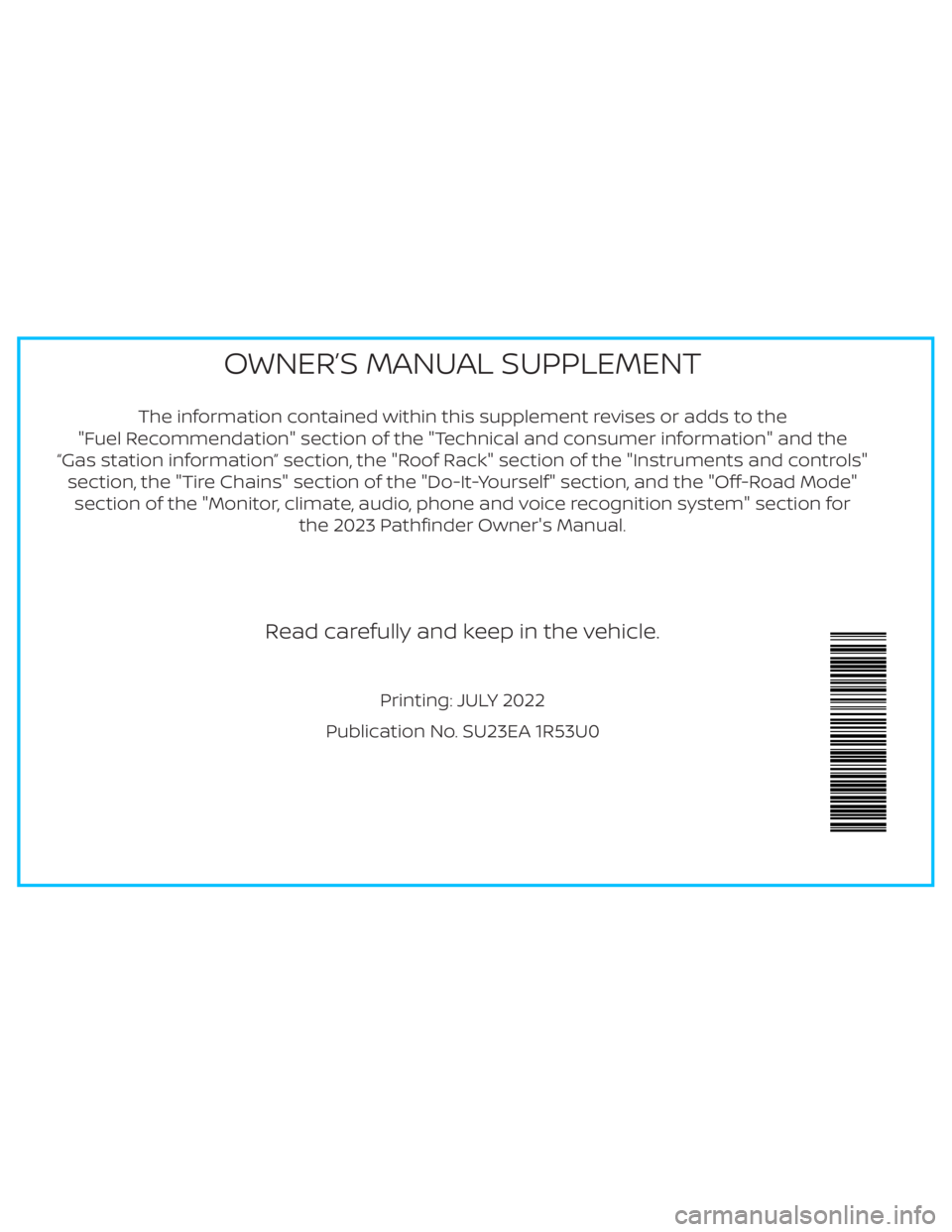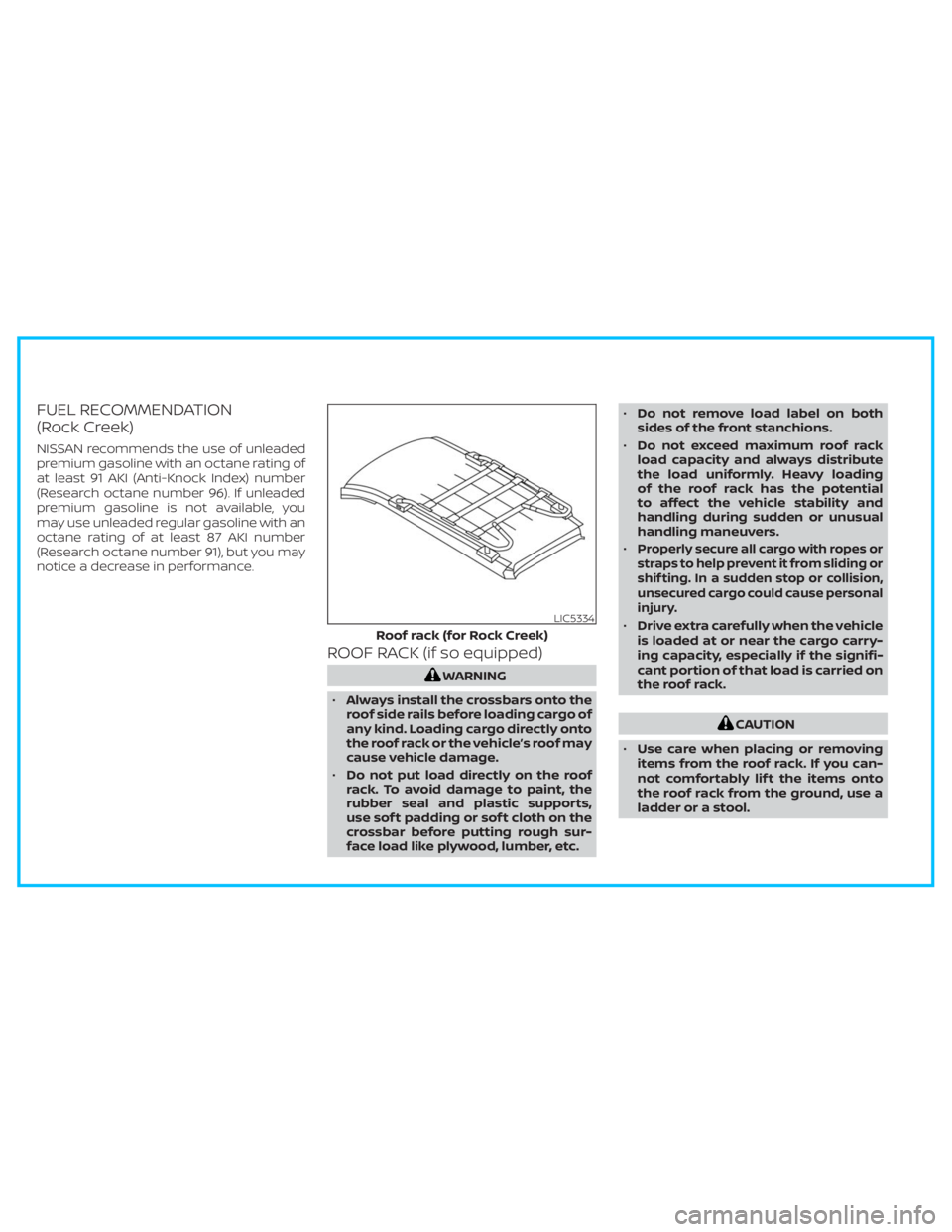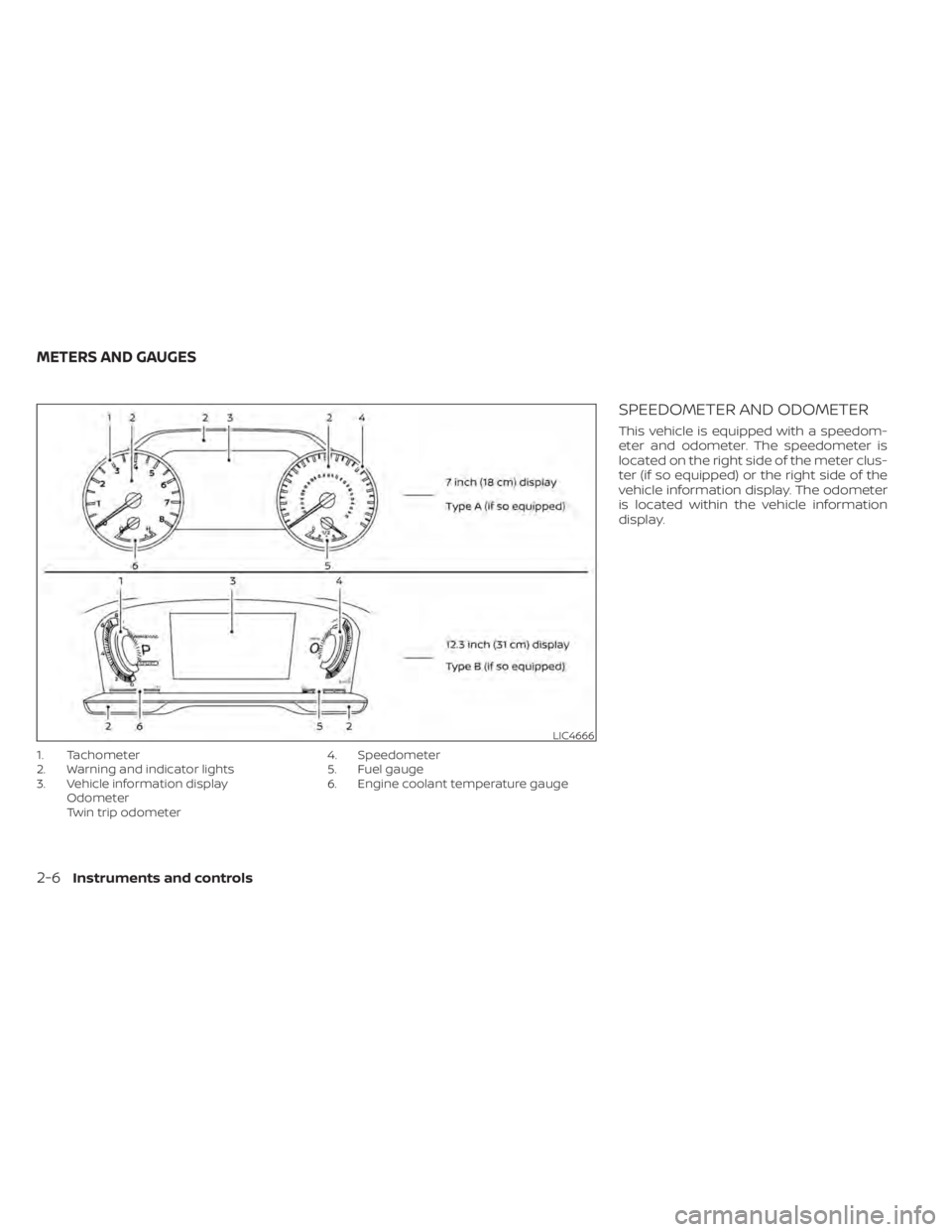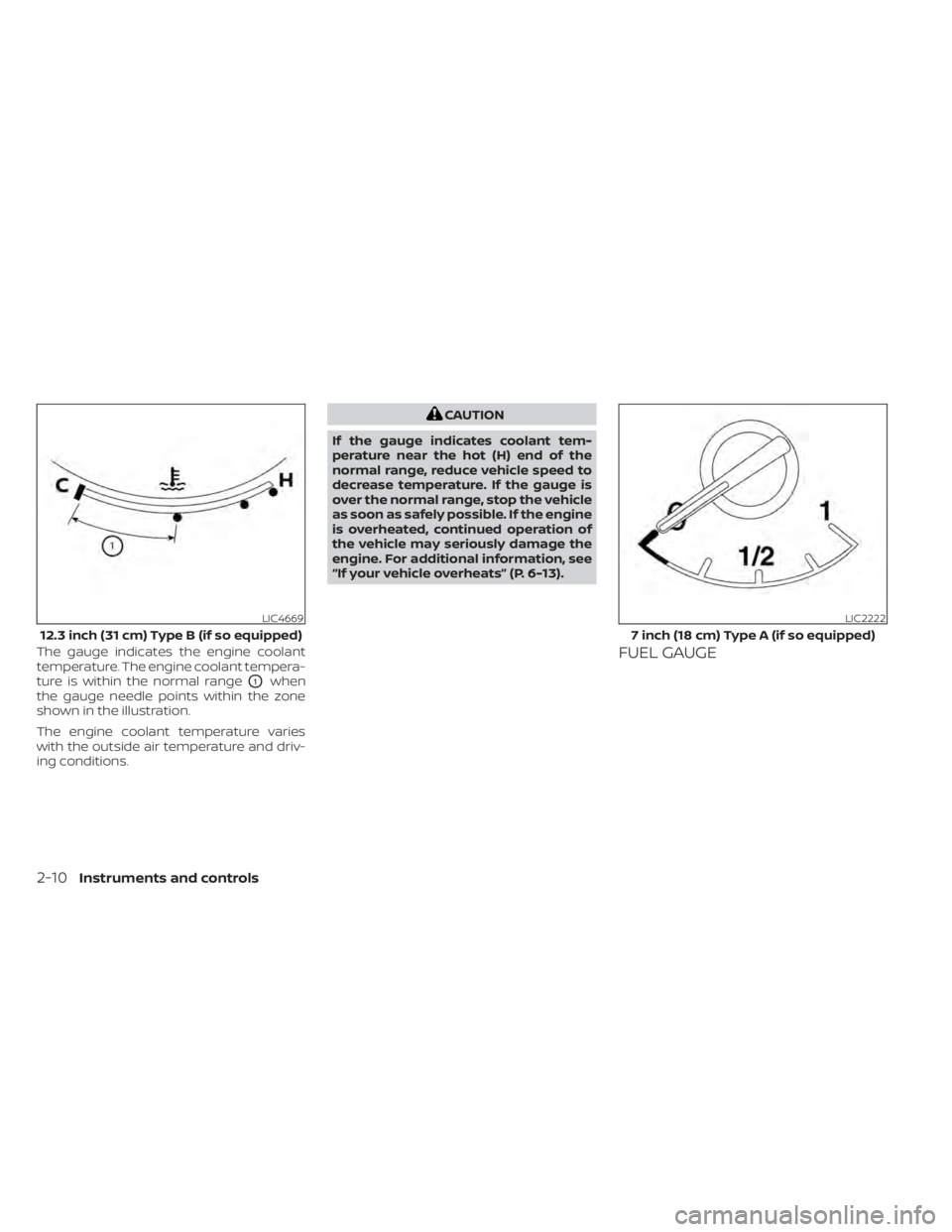2023 NISSAN PATHFINDER fuel
[x] Cancel search: fuelPage 4 of 665

The information contained within this supplement revises or adds to the
"Fuel Recommendation" section of the "Technical and consumer information" and the
“Gas station information” section, the "Roof Rack" section of the "Instruments and controls"
section, the "Tire Chains" section of the "Do-It-Yourself" section, and the "Off-Road Mode"
section of the "Monitor, climate, audio, phone and voice recognition system" section for
the 2023 Pathfinder Owner's Manual.
Read carefully and keep in the vehicle.
Printing: JULY 2022
Publication No. SU23EA 1R53U0
OWNER’S MANUAL SUPPLEMENT
Page 5 of 665

FUEL RECOMMENDATION
(Rock Creek)
NISSAN recommends the use of unleaded
premium gasoline with an octane rating of
at least 91 AKI (Anti-Knock Index) number
(Research octane number 96). If unleaded
premium gasoline is not available, you
may use unleaded regular gasoline with an
octane rating of at least 87 AKI number
(Research octane number 91), but you may
notice a decrease in performance.
ROOF RACK (if so equipped)
WARNING
•Always install the crossbars onto the
roof side rails before loading cargo of
any kind. Loading cargo directly onto
the roof rack or the vehicle’s roof may
cause vehicle damage.
•Do not put load directly on the roof
rack. To avoid damage to paint, the
rubber seal and plastic supports,
use sof t padding or sof t cloth on the
crossbar before putting rough sur-
face load like plywood, lumber, etc.•Do not remove load label on both
sides of the front stanchions.
•Do not exceed maximum roof rack
load capacity and always distribute
the load uniformly. Heavy loading
of the roof rack has the potential
to affect the vehicle stability and
handling during sudden or unusual
handling maneuvers.
•
Properly secure all cargo with ropes or
straps to help prevent it from sliding or
shif ting. In a sudden stop or collision,
unsecured cargo could cause personal
injury.
•Drive extra carefully when the vehicle
is loaded at or near the cargo carry-
ing capacity, especially if the signifi-
cant portion of that load is carried on
the roof rack.
CAUTION
•Use care when placing or removing
items from the roof rack. If you can-
not comfortably lif t the items onto
the roof rack from the ground, use a
ladder or a stool.
LIC5334
Roof rack (for Rock Creek)
Page 17 of 665

1. Rear window wiper and washer switch(P. 2-81)
2. Lif tgate release (P. 3-29) 3. Rearview camera (P. 4-3, 4-10)
4. Towing (P. 10-20)
5. Rear sonar sensors (P. 5-183)
6. Replacing bulbs (P. 8-26)7. Fuel-filler door (P. 3-31)
Fuel recommendation (P. 10-4)
8. Child safety rear door lock (P. 3-7)
Refer to the page number indicated in
parentheses for operating details.
LII2669
EXTERIOR REAR
0-4Illustrated table of contents
Page 108 of 665

2 Instruments and controls
Instrument panel................................2-4
Meters and gauges .............................2-6
Speedometer and odometer .................2-6
Tachometer ..................................2-8
Engine coolant temperature gauge ..........2-9
Fuel gauge .................................. 2-10
Distance To Empty (DTE) .....................2-11
Warning lights, indicator lights and audible
reminders ...................................... 2-12
Checking lights .............................. 2-14
Warning/Indicator lights (red) ...............2-14
Warning/Indicator lights (yellow) ............2-17
Warning/Indicator lights (other) .............2-22
Audible reminders ........................... 2-23
Vehicle information display 7 inch (18 cm)
Type A (if so equipped) ......................... 2-23
How to use the vehicle information
display ...................................... 2-24
Startup display .............................. 2-24
Trip computer ............................... 2-25
Oil control system (if so equipped) ...........2-28
Settings ..................................... 2-29
Vehicle information display warnings
and indicators ............................... 2-39
Vehicle information display 12.3 inch (31 cm)
Type B (if so equipped) ......................... 2-48How to use the vehicle information
display
...................................... 2-48
Startup display .............................. 2-49
Trip computer ............................... 2-50
Changing the meter screen view ............2-53
Oil control system (if so equipped) ...........2-54
Settings ..................................... 2-55
Vehicle information display warnings
and indicators ............................... 2-65
Security systems ............................... 2-76
Vehicle security system .....................2-76
NISSAN Vehicle Immobilizer System .........2-77
Wiper and washer switch .......................2-78
Switch operation ............................ 2-78
Rain-sensing auto wiper system
(if so equipped) .............................. 2-79
Rear switch operation .......................2-80
R
ear window and outside mirror
(if so equipped) defroster switch ...............2-81
Headlight and turn signal switch ...............2-82
Headlight control switch ....................2-82
LED Daytime Running Lights (DRL)
system ...................................... 2-87
Instrument brightness control ..............2-88
Turn signal switch ........................... 2-88
Fog light switch (if so equipped) .............2-89
Page 113 of 665

1. Tachometer
2. Warning and indicator lights
3. Vehicle information displayOdometer
Twin trip odometer 4. Speedometer
5. Fuel gauge
6. Engine coolant temperature gauge
SPEEDOMETER AND ODOMETER
This vehicle is equipped with a speedom-
eter and odometer. The speedometer is
located on the right side of the meter clus-
ter (if so equipped) or the right side of the
vehicle information display. The odometer
is located within the vehicle information
display.
LIC4666
METERS AND GAUGES
2-6Instruments and controls
Page 117 of 665

The gauge indicates the engine coolant
temperature. The engine coolant tempera-
ture is within the normal range
O1when
the gauge needle points within the zone
shown in the illustration.
The engine coolant temperature varies
with the outside air temperature and driv-
ing conditions.
CAUTION
If the gauge indicates coolant tem-
perature near the hot (H) end of the
normal range, reduce vehicle speed to
decrease temperature. If the gauge is
over the normal range, stop the vehicle
as soon as safely possible. If the engine
is overheated, continued operation of
the vehicle may seriously damage the
engine. For additional information, see
“If your vehicle overheats” (P. 6-13).
FUEL GAUGE
LIC4669
12.3 inch (31 cm) Type B (if so equipped)
LIC2222
7 inch (18 cm) Type A (if so equipped)
2-10Instruments and controls
Page 118 of 665

The gauge indicates theapproximatefuel
level in the tank.
The gauge may move slightly during brak-
ing, turning, acceleration, or going up or
down hills.
The gauge needle returns to 0 (Empty) af-
ter the ignition switch is placed in the OFF
position.
The low fuel warning message shows in
the vehicle information display when the
amount of fuel in the tank is getting low. Refill the fuel tank before the gauge reg-
isters 0 (Empty).
The
indicates that the fuel-filler door
is located on the driver's side of the vehicle.
CAUTION
• If the vehicle runs out of fuel, the
Malfunction Indicator Light (MIL) may
come on. Refuel as soon as possible.
Af ter a few driving trips, the
light
should turn off. If the light remains on
af ter a few driving trips, have the ve-
hicle inspected. It is recommended
that you visit a NISSAN dealer for this
service.
• For additional information, see “Mal-
function Indicator Light (MIL)”
(P. 2-20) or “Malfunction Indicator
(MIL)” (P. 2-68).
DISTANCE TO EMPTY (DTE)
Displays the estimated distance the ve-
hicle can be driven before refueling. The
value is calculated based on recent fuel
economy, the amount of fuel remaining in
the fuel tank, and the actual fuel
consumption. Changes in driving patterns or conditions
can cause the DTE value to vary. As a result,
the value displayed may differ from the ac-
tual distance that can be driven.
DTE display will change to “---” when the
fuel level in the tank is getting low, prior to
the fuel gauge reaching 0 (Empty).
NOTE:
• The DTE value af ter refill is estimated
based on recent fuel economy and
amount of fuel added.
• If a small amount of fuel is added, or the ignition is on during refueling, the
display may not be updated.
• Conditions that affect the fuel economy will also affect the estimated
DTE value (city/highway driving, idle
time, remote start time, terrain, sea-
sonal weather, added vehicle weight,
added deflectors, roof racks, etc.).
LIC4670
12.3 inch (31 cm) Type B (if so equipped)
Instruments and controls2-11
Page 127 of 665

•If the light illuminates while driving,
avoid sudden steering maneuvers or
abrupt braking, reduce vehicle
speed, pull off the road to a safe loca-
tion and stop the vehicle as soon as
possible. Driving with under-inflated
tires may permanently damage the
tires and increase the likelihood of
tire failure. Serious vehicle damage
could occur and may lead to an acci-
dent and could result in serious per-
sonal injury or death. Check the tire
pressure for all four tires. Adjust the
tire pressure to the recommended
COLD tire pressure shown on the Tire
and Loading Information label lo-
cated in the driver’s door opening to
turn the low tire pressure warning
light off. If the light still illuminates
while driving af ter adjusting the tire
pressure, a tire may be flat or the
TPMS may be malfunctioning. If you
have a flat tire, replace it with a spare
tire as soon as possible. If no tire is
flat and all tires are properly inflated,
have the vehicle checked. It is recom-
mended that you visit a NISSAN
dealer for this service. •
When using a wheel without the
TPMS such as the spare tire, the TPMS
will not function and the low tire
pressure warning light will flash for
approximately 1 minute. The light will
remain on af ter 1 minute. Have your
tires replaced and/or TPMS system
reset as soon as possible. It is recom-
mended that you visit a NISSAN
dealer for these services.
• Replacing tires with those not origi-
nally specified by NISSAN could af-
fect the proper operation of the
TPMS.
CAUTION
• The TPMS is not a substitute for the
regular tire pressure check. Be sure
to check the tire pressure regularly.
• If the vehicle is being driven at
speeds of less than 16 mph (25 km/h),
the TPMS may not operate correctly.
• Be sure to install the specified size of
tires to the four wheels correctly.
Malfunction Indicator Light
(MIL) (if so equipped)
If this indicator light comes on steady or
blinks while the engine is running, it may
indicate a potential emission control
malfunction.
The MIL may also come on steady if the
vehicle runs out of fuel. Check to make sure
that the vehicle has at least 3 gallons (11.4
liters) of fuel in the fuel tank.
Operation
The MIL will come on in one of two ways:
• MIL on steady — An emission control sys- tem malfunction has been detected.
Have the vehicle inspected. It is recom-
mended that you visit a NISSAN dealer for
this service. You do not need to have your
vehicle towed to the dealer.
• MIL blinking — An engine misfire has been detected which may damage the emis-
sion control system. To reduce or avoid
emission control system damage:
do not drive at speeds above 45 mph (72
km/h).
avoid hard acceleration or deceleration.
avoid steep uphill grades.
if possible, reduce the amount of cargo be-
ing hauled or towed.
2-20Instruments and controls